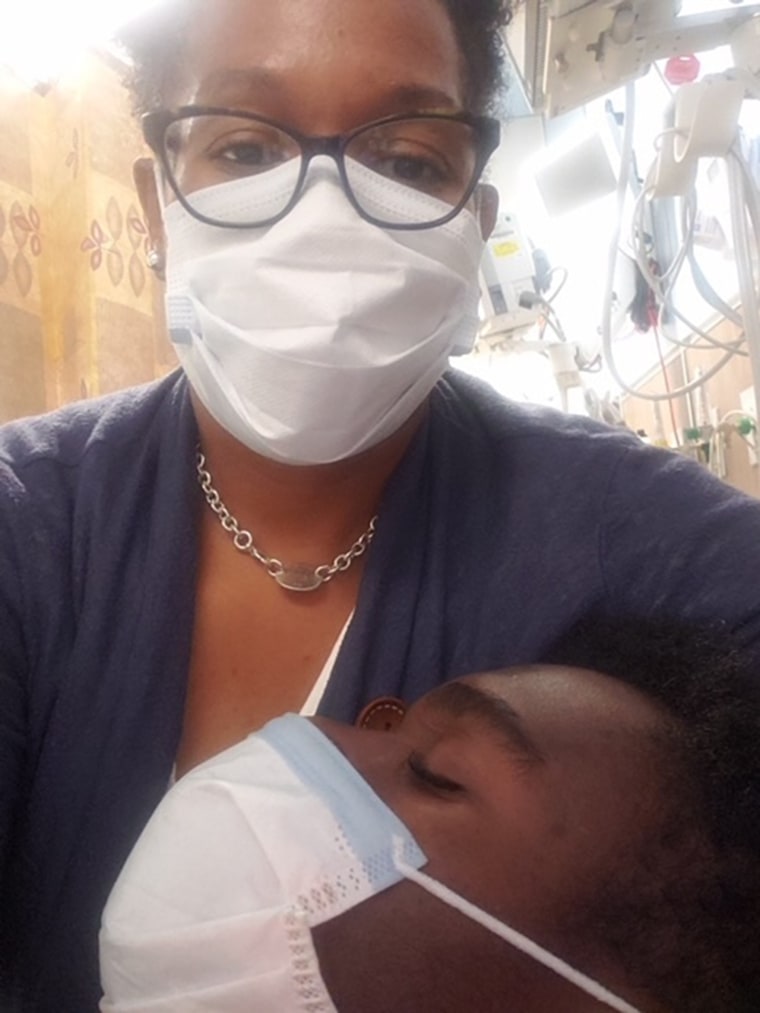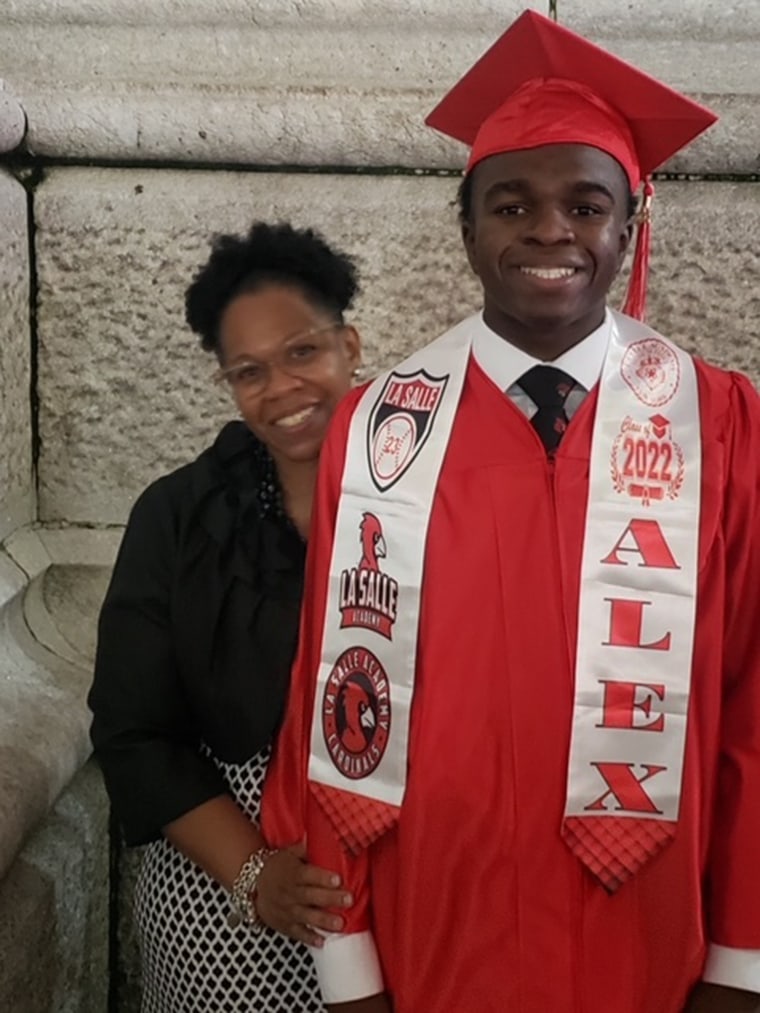In September 2021, Alexander “Alex” Dayle, a varsity first baseman at his high school, joined some teammates for an informal practice. Dayle tossed the ball to the batter who hit the ball, which slammed into his skull.
“Boom — line drive straight to the head,” the 17-year-old from New York City told TODAY. “My immediate reaction was to get up, but I literally couldn’t. I was on the ground for a long period of time, like 10 minutes, trying to get my bearings back.”
When Alex returned home, his mom and brother noticed something off with him. The next day, they visited the emergency department where he learned he had a large temporal hematoma, a blood clot, in his brain, and he needed immediate brain surgery.
“They said to us we really have just two choices you can schedule him for emergency surgery now or we’re going to schedule emergency surgery for him in two minutes,” Anita Walker, Dayle’s mother, told TODAY. “His head was basically about to pop off from the pressure.”
A surprise diagnosis
On the ride home from practice, Dayle felt nauseous. At home, he took some Tylenol and rested. He doesn’t often mention if he’s in pain so Walker wanted to keep an eye on him.
“There was no big knock on his head and you saw no blood. There was nothing that could indicate that there was some trauma. You didn’t see it,” Walker said. “He did throw up.”
Dayle didn’t tell his mom about his vomiting, but his brother mentioned it and Walker thought maybe he had a concussion. By that evening, Alex began experiencing extreme pain, like an “aggravated migraine” and light sensitivity.
“All of a sudden he was like, ‘OK turn off the lights. The lights are bothering me,’” Walker recalled. “It wasn’t like Alex to complain about anything.”
He slept but Walker stayed home from work at a financial services company to make sure he was improving. When Walker asked how he felt, he groaned and she decided to take him to the emergency room. There he received a CT scan for what Walker thought was a concussion.
“They showed us the images, which you can visibly see the brain bleed,” she said. “On the imagery it looks huge.”
Walker felt “numb” and peppered the staff with questions to understand what was happening. When she realized the severity of her son's condition, she went into “fight or flight mode.”

“Normally, I’m crying and I’ve got the ugly tears,” Walker said. “I didn’t even shed a tear. I was just like ‘What do I need to do to this to get him better.’ That’s all that I could think of.”Dayle’s memory of that time is a little spotty. He remembers doctors telling him he needed to have surgery but still thought he had a “pretty bad concussion.”
“I went with it because there’s nothing really I could do,” Alex said. “I just accepted my fate.”
Emergency surgery for a 'freak accident'
Dr. Peter Morgenstern, a pediatric neurosurgeon, was working when Dayle arrived at the emergency department at Mount Sinai Hospital. Morgenstern said Dayle had an intracerebral hemorrhage, “a bleed in the brain itself,” on his right side above his ear near the temporal bone, which is often thinner than other spots on the skull. But the bone wasn’t broken, “which is also really unusual.”
“It was a freak accident,” Morgenstern told TODAY. “He just got hit right in a vulnerable part of the skull.”
While Dayle experienced “pretty severe symptoms,” he didn’t look sick so Morgenstern believes the signs could have been missed. Luckily Walker had watched her son carefully and knew when he not well.
“He was clearly in really severe pain and his mom made it clear to me that he’s not a complainer,” Morgenstern said. “He’s a pretty stoic kid.”
Because the bone wasn’t broken, they ran a few more tests to make sure he didn’t have a tumor or some sort of blood vessel malformation that contributed to the bleeding. After ruling those out, they knew surgery was the best option.
“Alex had a sizable hemorrhage and I was worried about the risk of him deteriorating very quickly,” he explained.
Morgenstern opened the skull to remove the bleed.
“We basically suction out the blood clot and then we look at all the surrounding brain and we irrigate it with sterile fluid to clean everything out,” Morgenstern said. “If there’s anything that’s actively bleeding, we cauterize it and otherwise we then close everything back up again.”
They used his skull bones and “tiny titanium plates” to reconstruct his head.
“In kids that actually heals really well,” Morgenstern said. “Alex bounced back as quickly as any patient I’ve ever met. When I saw him the next morning he said he had a little bit of incisional and muscle pain where we did the surgery and a headache. But the pain that he had no was not as bad as the pain that he had when he was in the emergency room.”
Back on the field
Before his accident, Dayle hoped to play college baseball. As he recovered, there was a question about whether he could return to the sport he loved. Immediately after surgery, he woke in the pediatric intensive care unit and struggled to even speak.
“It was hard to even talk,” he said. “I have zero appetite. I’m not eating. Still severe light sensitivity so I’m barely keeping myself busy. It was rough.”
His friends and teammates visited him. One day, seven people packed into his room. Friends made signs and stood outside the hospital to keep up his spirits.
“That was really refreshing,” he said.
He had to do physical therapy first by walking up and down the hallway “to make sure his motor skills were intact,” Walker explained.
“First it was assisted then it was unassisted. Then he was able to go to the bathroom by himself,” Walker said. ““His recovery was pretty good.”
He felt so healthy that when he got out of the hospital he wanted to attend orientation for his senior year of high school, only a few days after his brain surgery.
“I was like, ‘Are you kidding me? Wait a minute, you just had brain surgery,’” Walker said.
School didn’t feel any different for Alex but he did have to wait to play baseball. About February, Morgenstern cleared him to start practicing.
“I generally suggest we hold off (sports) for a while as he recovers. But then once he’s recovered, he doesn’t have anything specifically that makes him vulnerable to future injury aside from the previous surgical site,” Morgenstern said. “I told him that I think he should wear a helmet.”

At first, the high school slugger felt frustrated.
“I felt like I was getting behind the curve a little bit,” he said. “I plan to play college baseball so I’m like this is an important fall for me.”
But he understood why he needed to wait. As time passed, though, the surgery became a distant memory and he’s looking forward to playing baseball in the fall at the Virginia State University.
“I feel like nothing ever really happened. I can’t really feel the scar anymore. I think about it here and there, like ‘Wow, that really happened,'” he said. “It’s just back to normal Alex now.”
CORRECTION (July 12, 2022, 2:06 p.m.): An earlier version of this article misstated the university Alex Dayle plans to attend in the fall. It is Virginia State University, not the University of Virginia.